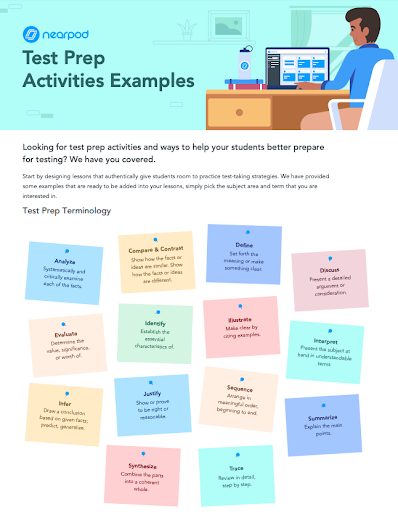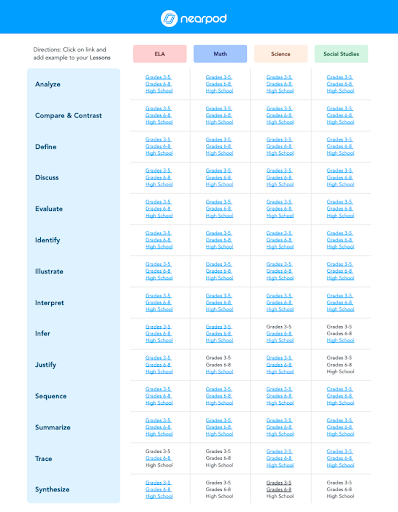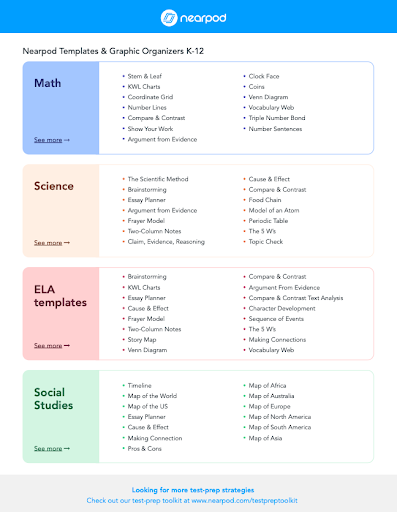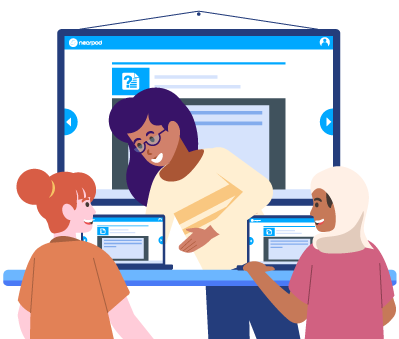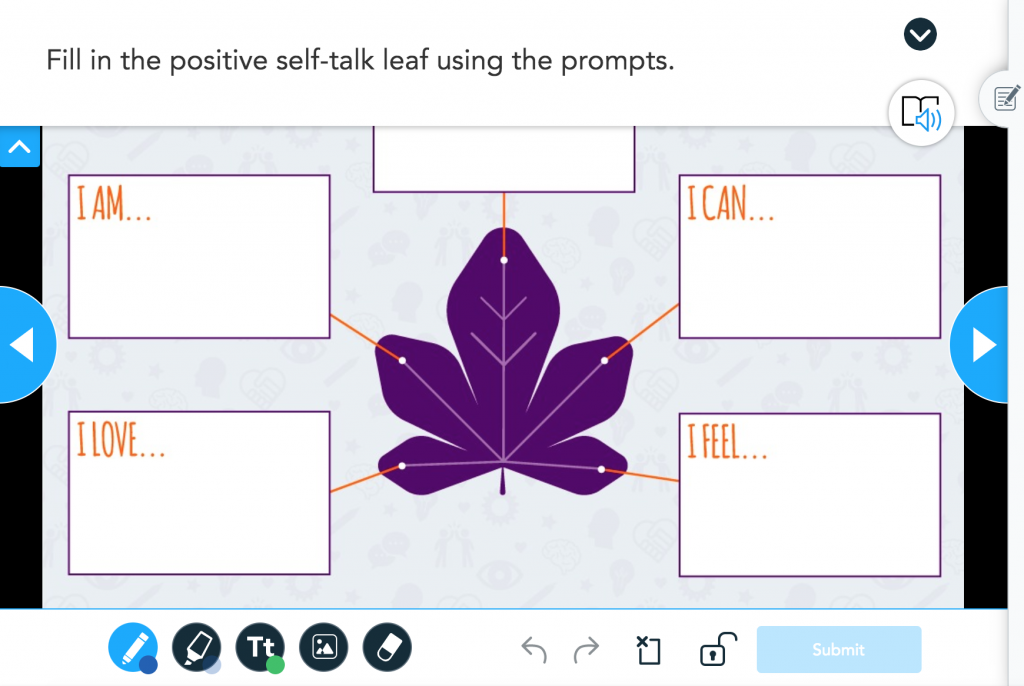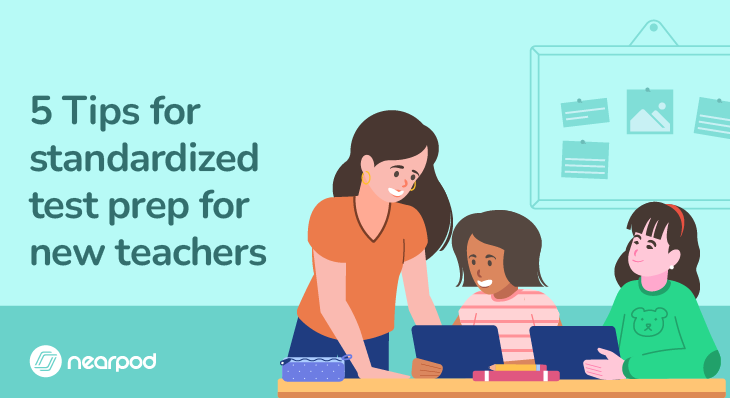
5 Tips for standardized test prep for new teachers
Every spring, classrooms across the states try to anticipate the state testing window by empowering students through basic standardized test prep strategies. While standardized testing practices continue to evolve to mitigate the high-stakes pressure for educators and students alike, most school communities will cop to a heightened sense of stress at the end of the school year. Such pressure can be especially overwhelming for new teachers. However, as one Nearpod team member sagely advises new and veteran educators alike, teaching test prep “is a process, not an event.”
New to Nearpod? Sign up for free to access the interactive lessons, activities, and resources we’ll share.
Why is standardized testing important?
With such a process in mind, teachers must remember that these standardized tests should represent culminating assessments designed to assess how well students have been taught to meet or exceed state standards throughout the year. Schools’ adopted curricula and approved programming should bolster teachers’ artistry in bringing grade-level content and skill sets to life each year. While students’ test scores are not meant to be indicators of a child’s intelligence or capacity to learn, we know that these scores can impact federal funding and schools’ rankings within a district and across a state. Ergo, there is pressure around standardized test prep.
How should a new teacher prepare students for standardized testing?
Whether you’re a new teacher or a veteran, “preparation” for these tests ought to be a yearlong event … basically what you do day in and day out — teaching and learning! By focusing on personalizing instruction, you can promote deeper learning. Through formative and summative assessments, you can better understand your students’ learning gaps and intervene as needed for individuals and small groups over time. Leveraging edtech throughout the years helps to familiarize students with computer literacy. And remember to teach to the whole child and address developing social emotional learning (SEL) skills to help set up students for success. So with an optimistic mindset, we suggest the following tips for preparing students for standardized tests.
5 Tips for standardized test prep for new teachers
1. Use engaging lessons and activities to review
Have you heard of the phrase “deeper learning”? According to Stanford University’s Linda Darling-Hammond, fusing content knowledge with real-life situations aids in transferring knowledge rather than memorizing it. Students are better equipped to tackle solving complex problems if they can make an authentic connection to how it is relevant to their interests and their world. With deeper learning, Professor Darling-Hammond says that “students tend to learn more deeply, and they tend to perform better, not only on traditional achievement tests but also on assessments of more complex understanding.”
With Nearpod, you can access a library of 22,000+ high-quality lessons, videos, and activities ready to use for teaching. If you’re interested in exploring premade activities you can use with your students for teaching test prep, download this PDF. You can use these resources to engage students in reviewing their standardized tests.
Test prep reviews
In the Lesson Library, search for standards-aligned lessons and activities within Nearpod using the search filter. You can filter by grade levels, standards, subjects, and activities. Then, consider duplicating the lesson and use the presentation editor to personalize the content and methodology to appeal to your students’ needs and interests. Ask yourself how you can connect the learning to their daily lives.
Here are some staff picks to choose from:
- Text Evidence (Grades 3-5): In this ELA test prep activity, students use text evidence to support an appropriate response. They complete a Draw it practice activity and quiz to measure their understanding of the lesson topic.
- Perimeter, Area & Volume (Grades 3-5): In this math test prep activity, students represent and solve problems related to perimeter and/or area and related to volume. They complete a Time to Climb activity and quiz to measure their understanding of the lesson topic.
- Context Clues (Grades 6-8): In this ELA test prep activity, students use context as a clue to the meaning of a word or phrase. They complete a Time to Climb practice activity and a quiz to measure their understanding of the lesson topic.
- Ratios (Grades 6-8): In this Math test prep activity, students use ratio language to describe a ratio relationship between two quantities. They complete a matching pairs practice activity and a quiz to measure their understanding of the lesson topic.
2. Identify any “holes” using real-time student data
Depending on which infographic, article, or research you dive into, there are various assessment types you, as an educator, could and should be using in the classroom for standardized test prep. Consider varying how you evaluate your students’ progress to ensure they have grasped the new content or skills and have a sound base on which to build. How are the skills being scaffolded over time? Suppose you have a good grasp on what the whole group, small groups, and individuals understand. In that case, you can strategize addressing any “holes” or gaps in comprehension through teacher test prep reviews or remediations. One effective active learning strategy to lean on closer to testing time is creating rotation stations to help refresh and solidify foundational and more complex concepts. You can even employ peer-to-peer learning to add variety to your instructional practice.
Nearpod’s interactive activities include several tools for formative assessment. You could use Polls, Drag and Drop, Draw It, Open-Ended Questions, Time to Climb, and more to assess students’ retention of new knowledge and skills in multiple ways. Interested in learning more about Nearpod’s formative assessment activities?
This variety of strategies allows you to appeal to a wide spectrum of learning styles, which will help paint a more complete and accurate picture of students’ progress. Assign an assessment activity to your students during class time, and you’ll see their responses on your device in real-time. You can also view post-session reports to see students’ data from the lesson. Lean on the real-time data to inform your next instructional steps and individualize students’ learning paths by following up with varied content from Nearpod’s vast lesson library.

3. Use edtech in a targeted way for standardized test prep
As you weave edtech such as Nearpod into your daily instruction, find ways to emphasize computer and digital literacy for standardized test prep. More and more states are offering online standardized testing, and for teachers and students alike, testing via digital devices can cause extra anxiety.
From keyboarding skills to moving the cursor to select, to scrolling to submit, to changing or revising an answer, students must have familiarity and feel comfortable navigating digital assessments. It is quite a balance to formulate responses while spending cognitive energy to utilize digital tools correctly. Give students regular practice for navigating technology and familiarizing themselves with the devices and their own work habits and styles (especially with the added pressure of timed tests).
By implementing Nearpod in your daily instruction leading up to testing, you can encourage your students to think tech-forward and be early adopters of these creative tools. Familiarize them with how technology can speak to their preferred learning style or aid their learning with assisted technologies.
4. Create sample tests for familiarity
More than likely, standardized tests — whether online or paper-based — are quite different from the quizzes and tests you normally give your students. Find ways to pepper in test questions throughout the year in a similar format so that your students become more familiar with the variety of test-taking strategies and how to best answer multiple-choice questions. You may also want to empower your students by understanding the power of elimination.
Standardized tests by design include above-grade level questions; students are not expected to ace the exams. However, when children encounter a question they do not know the answer to, they can still employ strategic problem-solving skills to think like a test maker or to make an educated guess. Encourage your students to get down to two choices to have a 50%-50% chance of selecting the correct answer based on what prior knowledge they do have.
See the following diagram to create test questions in Nearpod that mimic your state tests. You should be able to access practice tests online from your state’s test provider to understand better the common verbiage, framing, and layout of such questions.

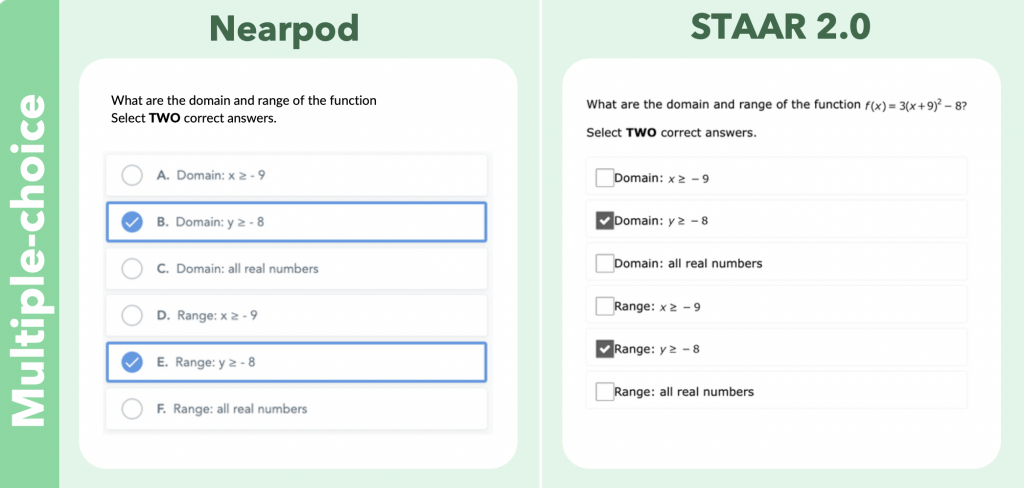
5. Practice a positive mindset
Try to help students mitigate their stress around test taking with some positive mindsets. Together, collaborate on some classroom mantras to post around the room. Practice deep breathing or model how to stimulate pressure points to help students find their center in a moment of stress. Do connect with students’ homes to help encourage early bedtimes for extra sleep and nutritious meals and snacks to keep energy high and consistent. Preparing mentally and physically will help students put their best foot forward during standardized testing.
With Nearpod’s social emotional learning (SEL) activities and lessons on test-taking strategies, teachers of all grade levels can help support students socially and emotionally when preparing for high-stakes assessments. Explore Nearpod’s 21st Century Collection, which includes SEL lessons that encourage goal setting, perseverance, and emotional regulation. These SEL skills will help students succeed through testing and beyond in life!
Start using Nearpod for teaching test prep
We hope you found these standardized test tips helpful! While there is no fast track to sail through standardizing testing each year, there are steps you can take all year long to teach test prep to mitigate anxiety around standardized testing. Consider how you can work within your grade level to team teach or remediate before testing begins. Work with school administrators to pump up school spirit during the long test weeks. Remind your students’ families that these tests are not markers of intelligence or indicators of capabilities but rather a measure of how well the school and educators have supported the children throughout the year.
With Nearpod, you can create your own interactive lessons and activities all in one place and access standards-aligned resources. Sign up for free now to use these tips and explore the power of Nearpod!

Darri Stephens is a dedicated LX (learning experience) designer, passionate about creating quality content and programs for kids, families, and educators. With MAs in Education from both Harvard and Stanford, and work experience at best-in-class ed tech organizations including Wonder Workshop, Nickelodeon, and Common Sense Education, she is steeped in the design thinking process and committed to agile and iterative project management, which has resulted in multi-award-winning programs and products.

